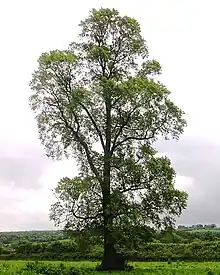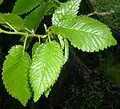Ulmus minor subsp. minor
Ulmus minor subsp. minor, the narrow-leaved elm (also known as smooth-leaved elm or East Anglian elm), was the name used by R. H. Richens (1983) for English field elms that were not English elm, Cornish elm, Lock elm or Guernsey elm.[1] Many publications, however, continue to use plain Ulmus minor for Richens's subspecies, a name Richens reserved for the undifferentiated continental field elms.[2] (Ulmus minor is native to southern Europe and Asia Minor including Iran.) Dr Max Coleman of Royal Botanic Garden Edinburgh argued in his 2002 paper 'British Elms' that there was no clear distinction between species and subspecies.[3]
| Ulmus minor subsp. minor | |
|---|---|
 | |
| Smooth-leaved elm at East Coker, Somerset, 2008 | |
| Scientific classification | |
| Kingdom: | Plantae |
| Clade: | Tracheophytes |
| Clade: | Angiosperms |
| Clade: | Eudicots |
| Clade: | Rosids |
| Order: | Rosales |
| Family: | Ulmaceae |
| Genus: | Ulmus |
| Species: | |
| Subspecies: | U. m. subsp. minor |
| Trinomial name | |
| Ulmus minor subsp. minor | |
| Synonyms | |
| |
In England, narrow-leaved elm is the commonest field elm in East Anglia, the East Midlands, and eastern Kent.[4][5]
Description
The smooth-leaved elm is a deciduous tree that can grow to 35 m. Its Latin synonym carpinifolia alludes to the superficial similarity of the leaves to those of hornbeam Carpinus sp., while the common names contrast the smooth upper surface and narrowness of the leaves with those of the wych elm, which are rough and broad.[6][7] The apetalous perfect wind-pollinated flowers, and fruit (samaras) are very similar to those of the species.
 Smooth-leaved elm foliage, May
Smooth-leaved elm foliage, May.jpg.webp) Smooth-leaved elm foliage, October
Smooth-leaved elm foliage, October
Pests and diseases
Although the smooth-leaved elm is generally susceptible to Dutch elm disease, it is genetically a highly variable tree and it is possible some specimens survive in the UK owing to an innately high level of resistance (see Cultivation). Research currently (2009) in hand by Cemagref at Le Pepiniére forestiére de l'Etat, Guémené-Penfao, France, should confirm this. However, all smooth-leaved elm varieties are believed to have been introduced into Britain from central and southern Europe during the Bronze Age,[8] and some, being beyond their natural climates and environments, may be growing slowly and thus producing smaller springwood vessels restrictive to the Ophiostoma fungus. Good performance in the field may also be owing to resistance to bark beetle feeding or breeding. Moreover, several types of this subspecies also have very pendulous twigs when mature, a factor which could also make them unattractive to foraging Scolytus beetles, which are disinclined to invert themselves.[9]
As the tree suckers readily, its genetic resources are not considered endangered.[10]
The subspecies has a moderate to high susceptibility to the elm leaf beetle, Xanthogaleruca luteola, and a moderate susceptibility to elm yellows.[11]
Cultivation
Many mature specimens still survive in England, notably in East Anglia.[12][13][14] The Woodland Trust currently lists (2013) some 120 surviving "ancient" smooth-leaved elms in England and Wales,[15] some of which are among the elms now being cloned, propagated and planted as part of The Conservation Foundation's 'Great British Elm Experiment' and 'Ulmus londinium' projects, a scheme to identify disease-resistant strains and return elms to city and countryside.[16][17][18] Among "varieties with most resistance", Professor Oliver Rackham noted (1986) the 'Boxworth elm',[19] still thriving (2022)[20] in and around Boxworth, Cambridgeshire,[21] and from c.2010 propagated experimentally by the Conservation Foundation.[22]
In a more academically-based project, most of the clones of the surviving European field elms that have been tested since the 1990s for innate resistance to Dutch elm disease by national research institutes in the EU, with a view to returning field elm to cultivation in Europe,[23] would be classified by Richens’s system as Ulmus minor subsp. minor. Results from Spain (2013), for example, confirm that a very small number of surviving field elms (about 0.5% of those tested) appear to have comparatively high levels of tolerance of the disease, and it is hoped that a controlled crossing of the best of these will produce resistant Ulmus minor hybrids for cultivation.[24]
Narrow-leaved elm was occasionally planted as an ornamental urban tree.




 East Kent narrow-leaved elms above Tonge Mill, near Sittingbourne (1969)[5]
East Kent narrow-leaved elms above Tonge Mill, near Sittingbourne (1969)[5]
Notable trees
The largest recorded tree in the UK grew at Great Amwell in Hertfordshire, measuring 40 m in height and 228 cm diameter at breast height (d.b.h.) in 1911.[30] Another famous specimen was the great elm that towered above its two siblings at the bottom of Long Melford Green, Long Melford, Suffolk,[31] till the group succumbed to disease in 1978. The three "were survivors of a former clone of at least nine elms, one dating from 1757".[32] The Long Melford elms were painted in 1940 by the watercolourist S. R. Badmin in his 'Long Melford Green on a Frosty Morning', now in the Victoria and Albert Museum.[33]
The largest known surviving trees are at East Coker, Somerset (30 m high, 95 cm d.b.h.), Termitts Farm near Hatfield Peverel, Essex (25 m high, 145 d.b.h.),[34] and Melchbourne, Bedfordshire, (147 cm d.b.h.).[35]
Cultivars
- Ulmus minor 'Argenteo-Variegata' (variegated smooth-leaved elm)
Hybrids and hybrid cultivars
The tree's natural range in eastern England overlaps with that of wych elm (Ulmus glabra), the two species hybridizing to produce elms of the Ulmus × hollandica group. Nursery cultivars in this group with English U. minor subsp. minor in their parentage include 'Vegeta', 'Cicestria', and 'Smithii'.
U. minor subsp. minor is believed to have hybridized also with Plot's elm to create elms of the Ulmus × viminalis group, presumed source of the cultivar 'Viminalis' or 'Antarctica'.
Accessions
North America
- Brooklyn Botanic Garden , New York, acc. nos. 350001, X02487 (as U. carpinifolia).
- Dawes Arboretum , Newark, Ohio. 3 trees, listed as U. carpinifolia, no acc. details available.
- Dominion Arboretum, Ottawa, Ontario, Canada. Listed as U. carpinifolia. No acc. details available.
Europe
- Brighton & Hove City Council, NCCPG Elm Collection.[36]
- Royal Botanic Garden, Wakehurst Place, as U. carpinifolia Gled., acc. nos. 1975-6201, 1977-6682, collected by Melville.
References
- Richens, R. H., Elm (Cambridge 1983), p.280
- Richens, R. H., Elm (Cambridge 1983), p.279
- Coleman M. (2002) 'British elms.' British Wildlife 13 (6): 390-395.
- Richens, R. H., Elm (Cambridge 1983), p.9
- Kentish Elm Conservation Project gallery, resistantelms.co.uk
- Stace, C. A. (1997). New Flora of the British Isles, 2nd edition. Cambridge University Press.
- White, J. & More, D. (2003). Trees of Britain & Northern Europe. Cassell's, London.
- Richens, R. H. (1983). Elm. Cambridge University Press.
- Webber, J. (2008). Dutch elm disease in Britain. Forest Research, Forestry Commission, Alice Holt, Farnham, Surrey
- Collin, E., Bilger, I., Eriksson, G. & Turok, J. (2000). The conservation of elm genetic resources in Europe, in Dunn, C. P., (Ed.) (2000) The Elms: Breeding, Conservation and Disease Management. Kluwer Academic Publishers, Boston, USA.
- Mittempergher, L; Santini, A (2004). "The history of elm breeding" (PDF). Investigacion Agraria: Sistemas y Recursos Forestales. 13 (1): 161–177.
- Gunner, Alec (2016-06-09). "East Anglian Elms - An assessment of characteristics of surviving trees". The 2016 International Elm Conference by The Conservation Foundation. Retrieved 2017-03-13.
- Miles, A. (2007) Hidden Trees of Britain. Ebury Press.
- Gibbs, J. N., Brasier, C. M., Webber, J. F. (1994) Dutch elm disease in Britain. Forestry Commission Research Note No. 252.
- The Woodland Trust, Tree Search
- Fifteen source-trees in England cloned for the Conservation Foundation's 'Great British Elm Experiment'; conservationfoundation.co.uk
- '"Super tree" from Northamptonshire helping to fight Dutch Elm Disease and repopulate woodlands', northamptonchron.co.uk Archived 2013-12-03 at the Wayback Machine
- "'Young elms return to London', The Conservation Foundation". Archived from the original on 2013-12-02. Retrieved 2013-11-17.
- Oliver Rackham, A History of the Countryside (London, 1986), p.241; Plate XXIc: 'Boxworth elm' at Knapwell, Cambridgeshire
- Wood of 'Boxworth elm' (East Anglian elms group), Boxworth, Cambridgeshire - Google Maps, November 2022, access date: February 15, 2023
- 'Boxworth elm', the Woodland Trust, Ancient tree inventory; ati.woodlandtrust.org.uk
- Photographs of young Boxworth elms, The Conservation Foundation: The Great British Elm Experiment; conservationfoundation.co.uk
- Screening European Elms for resistance to 'Ophiostoma novo-ulmi' (Forest Science 2005)
- 'Spanish Clones' (Oct. 2013) resistantelms.co.uk
- 'Elms of the Essex / Cambridgeshire border'; resistantelms.co.uk/galleries
- Mark Seddon, 'Back to the Future: the elms of Abbots Ripton', pressreader.com
- East Anglian elms at the west entrance to Abbots Ripton, Huntingdonshire - Google Maps, May 2021, access date: February 15, 2023
- Leaves of Dengie peninsula elms, Brian Eversham, 'Identifying British Elms, Ulmus '; Bedfordshire, Cambridgeshire, Northamptonshire Wildlife Trusts, v. 2.3.1 July 2021; p.99
- Dengie elms (field elms on the Dengie peninsula), Grange Road, south of Tillingham, Essex - Google Maps, August 2009, access date: 17 May, 2023
- Elwes, Henry John; Henry, Augustine (1913). The Trees of Great Britain and Ireland, Volume VII. Edinburgh. p. 1899. ISBN 9781108069380. Retrieved 15 December 2021.
{{cite book}}: CS1 maint: location missing publisher (link) - Photograph of the great elms on Long Melford Green (Francis Frith Collection, images.francisfrith.com)
- Photograph, plate XXI(h), in Oliver Rackham, A History of the Countryside (London, 1986), p.236.
- S. R. Badmin's 'Long Melford Green on a Frosty Morning', Victoria and Albert Museum
- Three summer photographs of the elms of Termitts Farm, between Hatfield Peverel and Terling, Essex; labelled 'Terling 2, 3, 4' in 'East Anglian Elm Gallery 2', resistantelms.co.uk/galleries
- Tree Register Of the British Isles (TROBI)
- "List of plants in the {elm} collection". Brighton & Hove City Council. Retrieved 23 September 2016.
